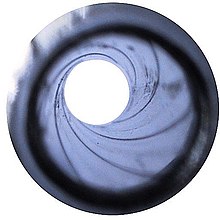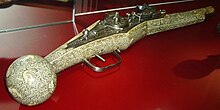Handgun
Handgun is the name given to one that can be carried by a single person and without additional people or additional aids, such as. B. Carriages , deployable firearm with a generally less than 20 mm caliber. In German legislation, a distinction is made between long guns (with barrel and closed breech longer than 30 cm and the shortest intended total length greater than 60 cm) and short guns (all others), also referred to as handguns - see: Appendix 1, Section 1, Subsection 1, No. 2.5 . to Section 1, Paragraph 4 of the Weapons Act .
Classification

The distinction is made:
- After handling with
- According to the design of the barrel or the type of ammunition to be fired from it in rifle with rifled barrel and shotgun with smooth barrel.
- According to length and caliber or firing mechanism in arquebus , musket , rifle , carbine and pistol .
- According to the form of reloading in single-shot , repeater and self-loading rifle , whereby there are different techniques for the individual forms.
- Special forms with the possibility of continuous fire are classified according to the caliber or the type of ammunition fired into submachine guns , automatic carbines (also known as assault rifles ) and machine guns (which are basically shot from a bipod or a mount).
- According to the type of propellant charge in black powder weapons and those with modern low-smoke powders and wind rifles
- After the way the weapon is loaded in the front and rear loader with cartridges
Firearms
The oldest firearms were very small and could not yet be properly broken down into small arms and guns. Partington proved in 1960 that the alleged first use of firearms in 1325 off Metz was a forgery. The first depiction of a firearm (cannon) by Walter de Milemete dates back to 1326. In contrast, the Friulian Chronicle proves that in 1331 German knights used such weapons for the first time in the unsuccessful storming of the northern Italian city of Cividale del Friuli , whereby a remarkable distinction was made between handpipe and gun has been. The pipes were cast from bronze; some of the gun barrels are even forged. Initially, stones and dammed arrows were fired, and by 1340 lead bullets were fired.
First handguns
The first handguns ( hand barrel or hand rifle ) were muzzle loaders . First, in analogy to the guns, they were ignited directly through the ignition hole with a smoldering fuse. The development of handguns made a first step forward with the invention of the matchlock (1411). The fuse glows after lighting. By means of a snap mechanism, when the trigger is pulled, the glowing fuse is pressed against the gunpowder and ignites. With this, the shooter is not concerned with igniting, but only with aiming. The subsequent introduction of the sight , the rear sight and the front sight as well as the rifled barrels around 1493 improved the accuracy enormously. However, since the rifled barrels had considerable disadvantages during the loading process, the smooth- barreled musket was the standard rifle until the middle of the 19th century . From 1517 the relatively complicated wheel lock was used for luxury weapons, which had the advantage of being able to do without the burning fuse.
At the Battle of Cerignola (1503), the use of handguns determined the course of the battle for the first time. When Cortés set out to conquer the Aztec empire in 1519 , his 508 soldiers owned bronze guns and 13 arquebuses .
The flintlock guns replaced the Luntenschlossmechanik from 1650, by a flint struck the ignition spark. The percussion lock , invented in 1807, uses powder for ignition. Since 1831, fiery mercury appeared in general as an ignition agent, which, installed in a few milligrams in copper primers, was able to transmit a flame to the powder due to its impact sensitivity. This made it possible to construct the unit cartridge, which consisted of a copper or brass case with primers in the bottom, the powder content and the attached projectile. This made the construction of the breech loader possible.
Modern handguns
In the middle of the 19th century, the accurate Minié bullet was introduced. From 1848 the Prussian army received the needle gun , which was to have a technical advantage, especially in the war of 1866 . Later developments led to the repeating rifles (Spencer, Henry , Winchester ) in the USA . Stock magazine rifles were introduced by Mauser and Mannlicher . The replacement of black powder by the new, more energetic, low-smoke powder from 1890 onwards enabled greater firing ranges and made the general use of the new machine guns possible due to the low smoke development.
Self-loading rifles were already in use in the First World War . The fully automatic gas pressure loader was used with the German machine carbine as the Sturmgewehr 44 (1943). The best-known representative of this type is the Soviet AK-47 assault rifle (developed in 1947 by Kalashnikov design office ), which has been manufactured over 70 million times to date. The American members of this genus is already in the Vietnam War used M16 . The worldwide widespread German representative of this type is the HK G3, a recoil loader with a roller lock.
The first machine guns, then still on a carriage , were introduced by Gatling (1860, hand-operated) and Maxim (1884, recoil-operated). The first large-scale use of machine guns took place in the First World War. Machine guns can only be classified as handguns to a limited extent according to their use - their weight and the strong recoil effect usually preclude their use as handguns. Often two soldiers were also used to operate a machine gun.
The pistol , also known as a handgun , was originally developed as a firearm for riders; the first, mostly single-shot models appeared around 1510. The intermediate step of a multi-load handgun was the revolver , which has a rotating drum as a magazine. Self-loading pistols with a magazine for cartridge ammunition appeared from 1893. Well-known models are the pistol 08 and the weapons from Glock , Carl Walther GmbH , Colt , Browning and Beretta as well as those from Heckler & Koch , as well as the Desert Eagle from Israel Military Industries .
The revolver is a subtype of pistols. With the revolver, the cartridge is pushed forward through a rotating drum. The development of the revolvers was determined by the Lefaucheaux pin fire revolver (1845) and the Colt Paterson from 1836, Colt Walker Mod. 1847 and, as a cartridge revolver, the "Peacemaker" (1873) in caliber 45 (11.4 mm).
The first submachine gun was developed in 1915 by the Italian Revelli ( Villar-Perosa M1915 ), the first capable of working in the field was the German Bergmann MP18 by the Suhl-based designer Hugo Schmeisser . American submachine guns became famous for Al Capone with the 1928 model . The most common submachine guns today are the Israeli Uzi and the German MP5 from Heckler & Koch .
Gun parts - attachments
Weapon parts are all parts of a weapon that are essential for the function of the weapon to fire a cartridge, including u. a. Exchange systems and insert barrels. The acquisition of weapon parts in Germany is subject to current law.
Attachment parts are often used for sport pistols to improve the hit results. Rubber covers on the handles improve the control of the weapon. Due to the higher mass of the pistol, additional weights reduce the knocking up of the weapon due to the recoil. The magazine can be changed faster with a magazine funnel .
Primarily for long guns, a telescopic sight can be mounted as an attachment through a bridge mount or a reflex sight, with which a simpler and more precise target acquisition is possible. With a Picatinny rail below , a laser light module such as an LLM01 can be mounted on both long and short weapons.
literature
- Heinrich Müller: rifles, pistols, revolvers. Stuttgart 1979.
- Erwin Schalkhausser: Handguns. Hunting rifles, target rifles, pistols (= catalogs of the Bavarian National Museum , Volume 19). Deutscher Kunstverlag, Munich a. a. 1988, ISBN 3-422-06025-1 .
- Arnold Wirtgen : Handguns and Prussian Army Reform 1807 to 1813 (= Defense Technology and Scientific Arms , Volume 3). Mittler, Herford u. a. 1988, ISBN 3-8132-0292-5 .
- Arnold Wirtgen: The Prussian handguns. Models, manufactories, rifle factories 1814 to 1856. Flintlock and percussion weapons (= military technology and scientific weapon knowledge , volume 16). Bernard & Graefe, Bonn 2004, ISBN 3-7637-6250-7 .
See also
Web links
- WaffenWiki
- Small Arms Survey - an independent and international research project of the Graduate Institute of International and Development Studies on various aspects of handguns

